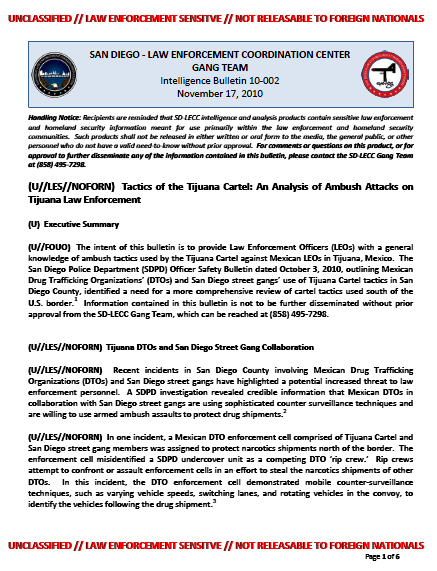This document was first released publicly via a tweet on the AnonymousIRC Twitter feed.
Tactics of the Tijuana Cartel: An Analysis of Ambush Attacks on Tijuana Law Enforcement
- 6 pages
- Law Enforcement Sensitive
- NOFORN
- November 17, 2010
(U//FOUO) The intent of this bulletin is to provide Law Enforcement Officers (LEOs) with a general knowledge of ambush tactics used by the Tijuana Cartel against Mexican LEOs in Tijuana, Mexico. The San Diego Police Department (SDPD) Officer Safety Bulletin dated October 3, 2010, outlining Mexican Drug Trafficking Organizations’ (DTOs) and San Diego street gangs’ use of Tijuana Cartel tactics in San Diego County, identified a need for a more comprehensive review of cartel tactics used south of the U.S. border.
…
(U//LES//NOFORN) Tijuana DTOs and San Diego Street Gang Collaboration
(U//LES//NOFORN) Recent incidents in San Diego County involving Mexican Drug Trafficking Organizations (DTOs) and San Diego street gangs have highlighted a potential increased threat to law enforcement personnel. A SDPD investigation revealed credible information that Mexican DTOs in collaboration with San Diego street gangs are using sophisticated counter surveillance techniques and are willing to use armed ambush assaults to protect drug shipments.
(U//LES//NOFORN) In one incident, a Mexican DTO enforcement cell comprised of Tijuana Cartel and San Diego street gang members was assigned to protect narcotics shipments north of the border. The enforcement cell misidentified a SDPD undercover unit as a competing DTO ‘rip crew.’ Rip crews attempt to confront or assault enforcement cells in an effort to steal the narcotics shipments of other DTOs. In this incident, the DTO enforcement cell demonstrated mobile counter-surveillance techniques, such as varying vehicle speeds, switching lanes, and rotating vehicles in the convoy, to identify the vehicles following the drug shipment.
(U//LES//NOFORN) SDPD received credible information that the leadership of this DTO enforcement cell mistook the undercover law enforcement personnel for an opposing cartel ‘rip crew.’ Using push-to-talk communications, the enforcement cell called for additional San Diego street gang members to recover automatic weapons from a San Diego stash house and move to a preplanned location in Southeast San Diego. The cartel convoy then attempted to lead the suspected ‘rip crew,’ in this case undercover SDPD Officers, into an ambush at the preplanned location.
…
(U//LES//NOFORN) Counter Ambush Techniques
(U//LES//NOFORN) This bulletin is not intended to provide guidance or training in counter ambush or counter surveillance techniques to U.S. law enforcement. However, certain overarching principals pertaining to officer safety in an ambush situation have been outlined below.
(U//LES//NOFORN) In the Field:
• Keep the vehicle moving, never stop in the “kill zone”
• Always turn into the vehicle in the direction of a Blind Side ambush
• Keep your front seat clear to lay down or exit either door if under fire
• Consider your vehicle an offensive weapon
• When possible, travel in the far left lane
• Have one car length between you and the car in front of you while stopped in traffic
• Check mirrors for surveillance vehicles (especially SUVs and Vans)
• Watch for more than one vehicle traveling in tandem
• Alternate daily routine and routes
• Appoint a ‘counter-surveillance officer’ as part of a team during operations
• Conduct random security checks of law enforcement stations
• When there is an overt threat, use ‘overwatch’ techniques on calls, stops, and operations(U//LES//NOFORN) In Training and Off-Duty Hours:
• Periodically conduct counter-surveillance training
• Practice vehicle-based shooting scenarios
• Train to respond to multiple ambush scenarios
• Develop, implement, and update a security plan for both home and duty hours(U) Conclusion
(U//FOUO) The use of cartel ambush tactics and techniques against San Diego law enforcement is currently assessed low. The potential for San Diego and Imperial county law enforcement being targeted as a case of mistaken identity as a competing cartel or ‘rip crew’ is assessed as moderate based on the recent events in the San Diego region. Considering recent reporting of Mexican DTO and San Diego street gang collaboration, law enforcement operating in an undercover or surveillance capacity should consider increased surveillance and counter-surveillance training.

